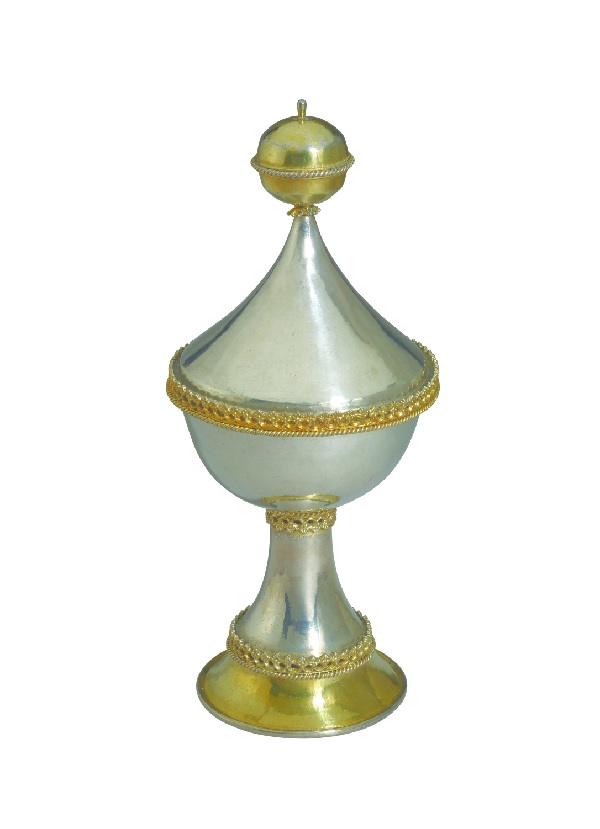The Lacock Cup was originally made as a drinking cup for feasting in the late medieval period and was subsequently used as a chalice at St Cyriac’s Church in Lacock until the mid 1980s. It is one of England’s most important silver objects as it is a rare survival of non-religious English medieval silver.
In the 19th century the cup was often singled out as a treasure of Wiltshire. In 1963 it was lent to the British Museum with a condition that it should return to St Cyriac’s Church for services at Christmas, Easter, Whitsun and Harvest. This arrangement continued until the mid 1980s when transporting the cup between London and Wiltshire became untenable for insurance reasons. In 2013 the church was given permission to sell the cup and it was jointly acquired by the British Museum and Wiltshire Museum, Devizes for £1.3 million with the support of the National Heritage Memorial Fund, the Art Fund and private donations.
Find out more about the Cup in this short talk:-
The Cup is fully described in the British Museum website catalogue entry by Naomi Speakman and Loyd de Beer:
Silver-gilt drinking cup with lid, cast. The bowl of the cup is hemispherical in shape and is soldered at its base to a trumpet shaped foot. The lid is conical, topped with a finial and a spherical knop from which protrudes a small silver wick. The cup and lid are decorated with a twisted ropework pattern combined with an openwork crenelated motif which is applied at three different points; above the base and below the bowl of the cup, along the rim of the lid. There is gilding at the base of the foot, across the outside of the lip of the bowl and the knop; the finial, wick, ropework and crenellations have also been gilded.
The Lacock Cup is a rare survivor from medieval England. Produced in the 15th century, it was originally a drinking cup made for feasting and after the Reformation was used by the Church of Saint Cyriac in Lacock, Wiltshire, as a chalice for communion. As an object which has been central to shared consumption, of wine at a feast and wine for the sacrament, the Lacock Cup tells these two stories of its original secular context and later religious status. Despite the contemporary popularity of objects such as the Lacock Cup, few pieces of secular silver survive today - the majority of cups would have been melted down for their metal value or refashioned due to changing tastes. Although we cannot be certain exactly when the Lacock Cup was donated to St Cyriac's, the two centuries following the Reformation in England are the most likely time period in which such a gift would have been valued and preserved.
The nineteenth and twentieth centuries brought the Lacock Cup into public view in a very different way, through its inclusion in publications and exhibitions. The importance of the Cup must have always been apparent, to those in the parish, when it was used in the church, and in regional surveys of the nineteenth century, the Cup was often singled out as a treasure of Wiltshire. Its condition is a testament to this recognition as it has survived immaculately.
Over the years the history of its donation was lost and it was only in the twentieth century that the wider historical importance of the Cup was realized. In 1937 and 1955 the Cup made two trips to exhibitions (Treasures of the West Country and Silver Treasures from English Churches respectively), the first at Bristol, and the latter at Christie's in London for the Historic Churches Preservation Trust. The 1955 exhibition catalogue described it as an 'extremely rare and interesting cup.' Following a loan to Vienna in 1962, for the exhibition European Art around 1400, the lending of the Cup was agreed to the British Museum by the Keeper of the Department of British and Medieval Antiquities, R.L.S. Bruce-Mitford, and the Rector the Reverend Mr. G.R. Brocklebank.
After twenty years on loan to the British Museum, the transporting of the Cup back to St Cyriac's became untenable for insurance reasons. From this point the Cup was looked after by the British Museum, where it has been on permanent display ever since. The Cup was acquired by the Museum in December 2013.
For a full discussion of the Lacock Cup please see: L. de Beer & N Speakman, The Lacock Cup, (London: British Museum Press, 2014). Available for purchase at the Museum


